Welcome to our guide on maintaining and caring for your printer’s printhead. The printhead plays a crucial role in transferring ink onto paper, ensuring clear and vibrant prints. However, when the printhead gets clogged, it can lead to faded or streaky prints that can be frustrating to deal with.
To prevent printhead clogging and ensure optimal print quality, it’s important to practice routine printer care and maintenance. By following some simple steps and best practices, you can minimize the chances of clogging and enjoy crisp prints every time.
Key Takeaways:
- Regularly use your printer to prevent ink from drying on the printheads.
- Clean the printhead with rubbing alcohol, a clean cloth, and a vacuum cleaner to remove any residue and prevent clogging.
- Choose the right printer with a metal core PCB to regulate thermal conditions.
- Properly store your printer, use a dust-proof enclosure, and secure removable printheads separately.
- Turn off your printer using the power button to protect the printheads.
Regular Printer Use and Printhead Cleaning
Regular printer use and proper printhead cleaning are essential for maintaining optimal print quality and preventing ink drying or clogging issues. By following these simple steps, you can ensure that your printer operates smoothly and delivers crisp prints every time.
Regular Printer Use
Using your printer regularly is one of the most effective ways to prevent ink from drying on the printheads. When a printer sits idle for an extended period, the ink can dry, leading to clogged nozzles and poor print quality. It is recommended to use your printer at least once every few days or once a week to keep the ink flowing smoothly.
To incorporate regular printer use into your routine, consider printing a test page or a small document even if you don’t have a specific print job. This practice helps keep the printheads active and ensures proper ink flow.
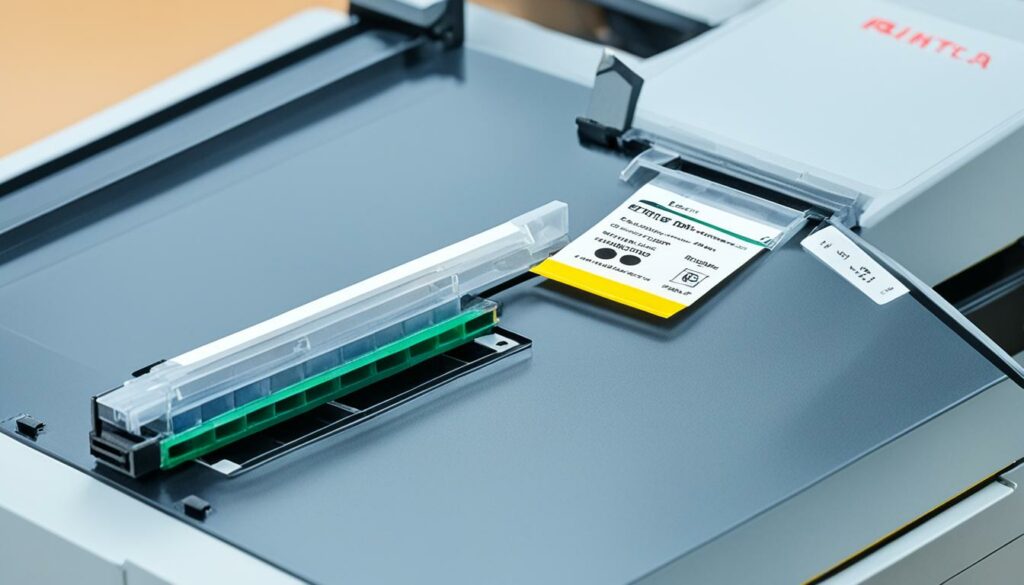
Printhead Cleaning
In addition to regular printer use, printhead cleaning is crucial to maintain optimal performance. Over time, ink residue can accumulate on the printheads, leading to clogs and streaky prints. Cleaning the printhead helps remove this residue and ensures clear nozzle passage.
To clean the printhead, follow these steps:
- Prepare a soft, lint-free cloth and a small amount of rubbing alcohol.
- Gently wipe the printhead surface using the alcohol-dampened cloth. Be careful not to apply excessive pressure or scratch the printhead.
- If necessary, use a vacuum cleaner with a soft brush attachment to remove any loose debris or dust particles from the printhead.
- Repeat the cleaning process if there are still visible residues on the printhead.
Regular printhead cleaning not only helps prevent ink clogs but also improves print quality by ensuring consistent ink flow and precise nozzle performance.
Printhead Cleaning Frequency
| Printer Usage | Recommended Cleaning Frequency |
|---|---|
| Light usage (occasional prints) | Once every 4-6 weeks |
| Moderate usage (weekly prints) | Once every 2-3 weeks |
| Heavy usage (daily prints) | Once every week |
Quote: Taking care of your printhead is a small effort that goes a long way to ensure optimal print quality.
Regular printer use and printhead cleaning are simple yet effective maintenance practices that can prevent ink drying, clogging, and ultimately lead to better print results. By incorporating these routine tasks into your printing habits, you can enjoy hassle-free printing and vibrant, professional-looking prints.
Opting for the Right Printer
Choosing the right printer is crucial when it comes to preventing printhead clogging. It’s important to consider various factors such as the type of printer and its components to ensure optimal performance and longevity. Let’s take a closer look at some key considerations:
Inkjet vs. Laser
One of the first decisions to make is whether to go for an inkjet or laser printer. Inkjet printers are commonly used for home and small office use, offering versatility and the ability to produce high-quality photo prints. On the other hand, laser printers are better suited for high-volume printing and are known for their fast printing speed and sharp text quality. Consider your specific printing needs and requirements to determine which type of printer would be the best fit for you.
Metal Core PCB
When choosing a printer, it’s worth considering models that come equipped with a metal core PCB (Printed Circuit Board). This component helps regulate the thermal conditions within the printer, preventing overheating and extending the lifespan of the printhead. The metal core PCB aids in maintaining a stable temperature during printing, reducing the risk of printhead clogging caused by excessive heat buildup. Look for this feature in the printer specifications to ensure optimal performance and reliability.
The following table provides an overview of the main differences between inkjet and laser printers:
| Printer Type | Inkjet | Laser |
|---|---|---|
| Print Quality | High-quality photo prints | Sharp text quality |
| Printing Speed | Slower | Fast |
| Volume | Low to medium | High |
| Cost per Page | Higher | Lower |
Table: Inkjet vs. Laser Printers
Choosing the right printer with a metal core PCB and considering the inkjet vs. laser options based on your specific needs will help ensure that you have a reliable and efficient printing solution that minimizes the risk of printhead clogging.

Proper Equipment Storage
Storing your printer properly is crucial to protect the printhead and ensure its longevity. By following a few simple steps, you can prevent damage and maintain optimal performance.
Use a Dust-Proof Enclosure
When your printer is not in use, it is essential to keep it protected from dust and debris. Using a dust-proof enclosure can help shield the printer from environmental particles that may clog the printhead. This ensures that your printer remains clean and ready for high-quality prints whenever you need it.
Securely Store Removable Printheads
If your printer has removable printheads, it is recommended to store them securely in a separate enclosure. This prevents them from getting damaged or contaminated while not in use. By storing the printheads separately, you can minimize the risk of clogging and maintain their functionality.
Wrap Ink Cartridges in Cling Wrap
When you plan on leaving your printer unused for an extended period, it is advisable to remove the ink cartridges and wrap them tightly in cling wrap. This helps seal the cartridges and prevents them from drying out. By protecting the ink cartridges, you can ensure that the ink flows smoothly through the printhead and maintains its quality.
By implementing these storage practices, you can protect your printhead, extend its lifespan, and enjoy consistent, high-quality prints.
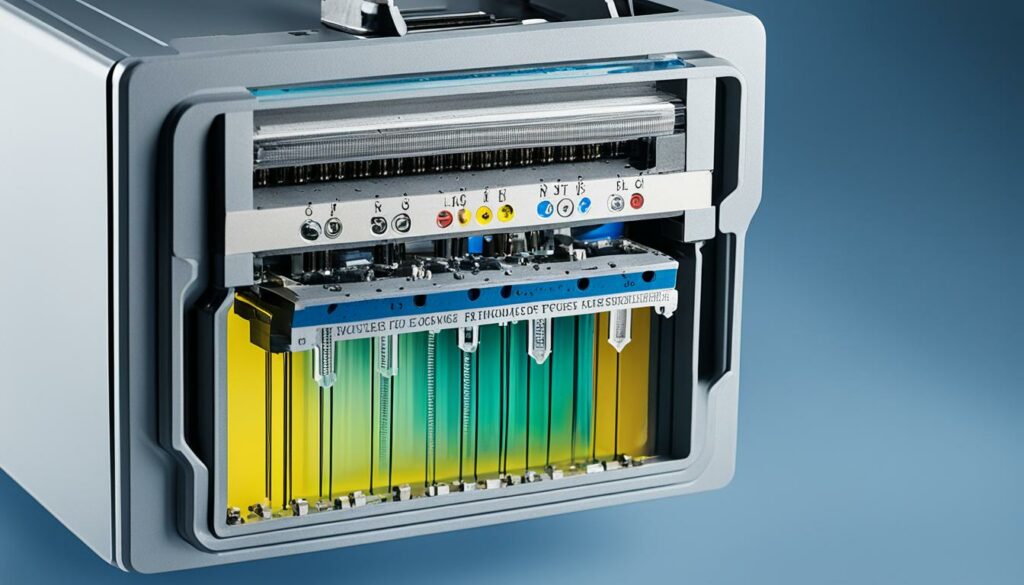
Switching Printer Off
When it comes to preventing clogging and protecting printheads, a simple yet effective practice is to switch off your printer after use. By turning off your printer using the power button, you allow the printheads to reset and the carriage to return to its original position. This helps prevent clogging and drying of the printhead, ensuring optimal performance and print quality in the long run.
By shutting down your printer properly, you create a clean slate for the next print job, reducing the risk of clogs and blockages. This is especially important if you won’t be using the printer for an extended period.
Remember, a properly shut down printer is a protected printer. Prevent clogging, promote longevity, and keep your prints crisp by simply turning off your printer after each use. It’s a small step that can make a big difference in maintaining the health of your printheads.
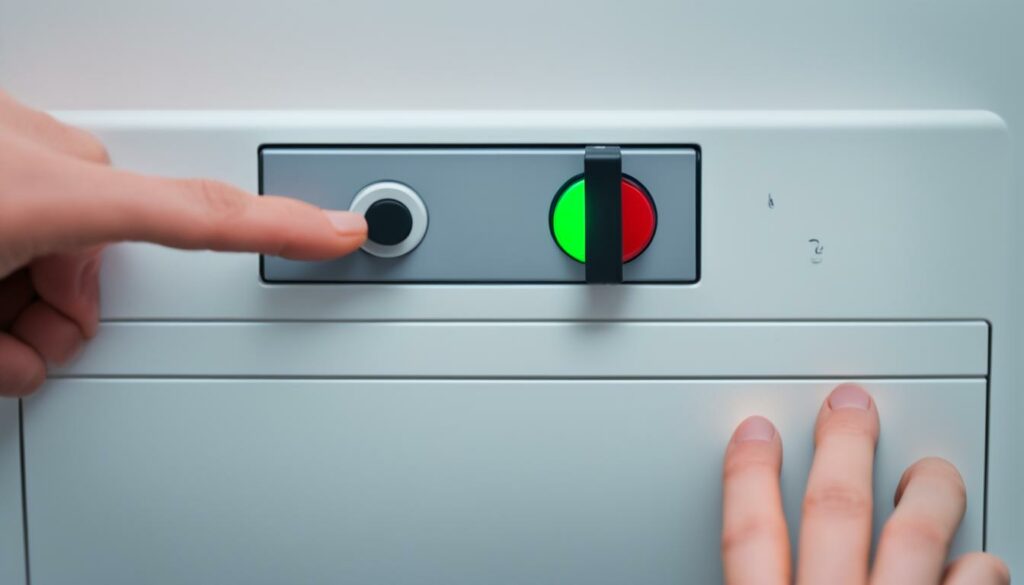
Benefits of switching off your printer:
- Prevents printhead clogging and drying
- Ensures printheads reset to their original position
- Promotes optimal print quality and performance
- Reduces the risk of blockages and maintenance issues
How to switch off your printer:
- Finish all print jobs and wait for the printer to complete its tasks.
- Locate the power button on your printer.
- Press and hold the power button until the printer shuts down completely.
- Wait for a few seconds before disconnecting the power cord, if needed.
Pro Tip: Avoid unplugging the printer directly from the power source without properly shutting it down. This can potentially damage the printer and printheads.
Using a Wetter Solution
When it comes to maintaining the moisture around your printhead and preventing ink from drying, a wetter solution can be a game-changer. This solution is readily available for all types of printers and can serve various purposes, such as storage or shipping. By adding just a few drops of wetter solution directly to the printhead, you can effectively prevent clogging, especially during long periods of inactivity.
Aside from its clog prevention capabilities, a wetter solution helps to maintain the optimal moisture level around the printhead. This is crucial for ensuring smooth ink flow and minimizing the risk of ink drying, which can lead to poor print quality and costly printhead repairs.
Why Choose a Wetter Solution?
A wetter solution acts as a barrier, protecting the printhead from the external environment and preventing the ink from evaporating. It creates a microclimate that maintains the necessary moisture around the printhead, even during extended periods of printer inactivity. By utilizing a wetter solution, you can safeguard your printhead and maintain its performance over time.
Using a wetter solution is like providing your printhead with an exclusive moisture shield that prevents ink from drying and reduces the chances of clogging.”
Moreover, a wetter solution is designed to be compatible with various printers, making it a versatile choice for anyone looking to improve print quality and extend the lifespan of their printheads. It is a simple yet effective solution that can significantly enhance the overall printing experience.
How to Use a Wetter Solution
Using a wetter solution is easy and straightforward. Here’s a step-by-step guide:
- Ensure your printer is powered off and unplugged.
- Locate the printhead area on your printer.
- Using a clean dropper or syringe, add a few drops of the wetter solution directly onto the printhead surface.
- Allow the wetter solution to spread evenly across the printhead.
- If needed, gently move the printhead carriage back and forth to distribute the wetter solution.
- Let the wetter solution sit on the printhead for a few minutes to fully penetrate and moisturize.
- Remove any excess wetter solution with a clean, lint-free cloth or cotton swab.
- Power on your printer and perform a nozzle check or test print to ensure that the wetter solution has effectively improved ink flow.
The Benefits of Using a Wetter Solution
Here are the key benefits of incorporating a wetter solution into your printer maintenance routine:
| Benefits | Description |
|---|---|
| Prevents Ink Drying | A wetter solution maintains moisture levels around the printhead, preventing ink from drying and ensuring consistent print quality. |
| Reduces Printhead Clogging | By keeping the printhead moisturized, a wetter solution minimizes the occurrence of clogs and improves overall print reliability. |
| Extends Printhead Lifespan | Regular use of a wetter solution helps to protect the printhead, prolonging its lifespan and reducing the need for frequent replacements. |
| Enhances Print Quality | A wetter solution promotes optimal ink flow, resulting in sharper, more vibrant prints with improved color accuracy. |
| Effortless Maintenance | Using a wetter solution is a simple yet effective maintenance practice that requires minimal time and effort. |
By incorporating a wetter solution into your printer maintenance routine, you can ensure optimal printhead performance, prevent ink drying, and maintain the overall print quality of your documents and images.
Printer Maintenance for DTF and DTG
For DTF and DTG printers, regular maintenance is crucial to prevent printhead clogging. Using a cleaning solution specific to these printing methods and following the recommended cleaning process can help keep the printhead clear and prevent blockages.
DTF printing and DTG printing are popular techniques for creating high-quality prints on various materials. However, without proper maintenance, these printers are prone to printhead clogging, which can affect print quality and productivity.
To prevent clogging and ensure smooth printing operations, it is important to use a cleaning solution that is specifically designed for DTF and DTG printers. These cleaning solutions are formulated to effectively dissolve ink residues and prevent buildup within the printhead.
When cleaning your DTF or DTG printer, follow the manufacturer’s guidelines and recommended cleaning process. This may involve flushing the printhead with the cleaning solution, either manually or using automated cleaning functions, to remove any accumulated ink and prevent clogging.
Regular maintenance should be scheduled to ensure the optimal performance of your DTF or DTG printer. This includes routine cleaning of the printhead, as well as inspecting and cleaning other components such as the capping station, ink lines, and dampers.
By implementing a regular cleaning and maintenance routine using the appropriate cleaning solution, you can prevent printhead clogging and ensure consistent print quality for your DTF and DTG prints.
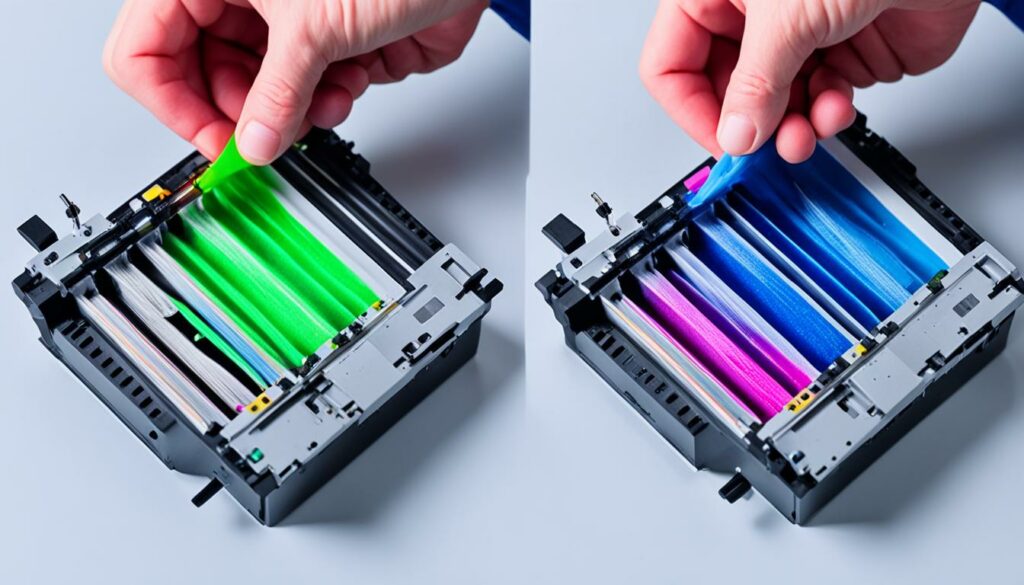
Maintenance Checklist for DTF and DTG Printers
| Task | Frequency |
|---|---|
| Flush printhead with cleaning solution | After every print job |
| Inspect and clean capping station | Weekly |
| Clean ink lines and dampers | Monthly |
| Perform nozzle checks | Weekly |
| Calibrate printhead alignment | Monthly |
Following this maintenance checklist will help prevent clogging and ensure optimal print performance for your DTF and DTG printer. Consult your printer’s user manual for specific guidelines and recommendations.
Keeping White Ink Flowing in Epson Printheads
When it comes to Epson printheads, maintaining the flow of white ink can pose a challenge. However, there are several strategies you can employ to keep your white ink flowing smoothly and prevent clogging.
One essential practice is to regularly use the self-clean function on your Epson printer. This function helps clear any blockages in the printhead, ensuring a consistent flow of ink. By incorporating regular self-cleaning into your printer routine, you can minimize the risk of clogs and maintain optimal print quality.
Filling the capping station with a cleaning solution is another effective way to prevent clogging in Epson printheads. The cleaning solution helps dissolve any residue or dried ink that may impede the flow of white ink. By regularly replenishing the capping station with a compatible cleaning solution, you can enhance the lifespan of your printheads and ensure reliable white ink performance.
Another factor to consider is the environment in which your printer operates. Low humidity levels can cause ink to dry faster, leading to potential clogs in the printheads. To counteract this, using an evaporative humidifier in your print room can help maintain an optimal humidity level, preventing ink drying and ensuring smooth white ink flow.
To visualize the strategies mentioned above, refer to the table below:
| Strategies | Benefits |
|---|---|
| Regular self-cleaning | Maintains optimal flow of white ink |
| Filling capping station with cleaning solution | Prevents clogs and extends printhead lifespan |
| Using an evaporative humidifier | Maintains humidity to prevent ink drying |
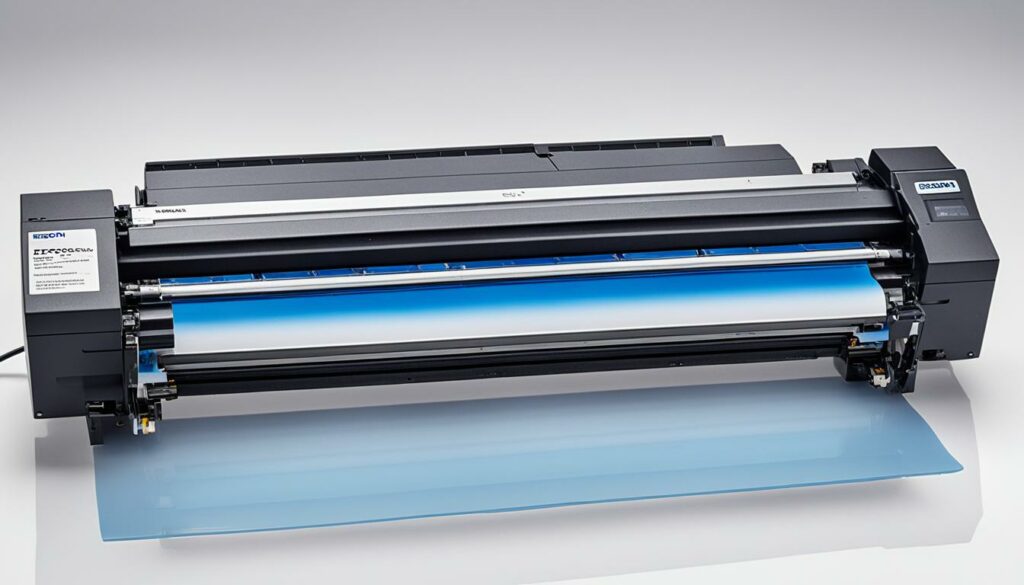
Implementing these practices will help you maintain white ink flow in your Epson printheads, ensuring optimal print quality and preventing frustrating clogs. By regularly utilizing the self-clean function, filling the capping station with a cleaning solution, and maintaining a suitable printing environment, you can achieve consistent and vibrant prints.
Benefits of Using a Conditioner for Printhead Maintenance
When it comes to printhead maintenance, using a conditioner specifically designed for this purpose offers numerous benefits. A printhead conditioner helps prevent clogging and maintains moisture around the printhead, ensuring optimal printer performance and print quality.
One of the key advantages of using a printhead conditioner is its ability to prevent clogging. Clogs in the printhead can cause print quality issues such as fading or streaking. By using a conditioner regularly, you can keep the printhead clean and free from obstructions, resulting in consistent and high-quality prints every time.
Additionally, a printhead conditioner helps maintain moisture around the printhead. Ink drying is a common problem that can lead to clogs and poor ink flow. By keeping the printhead moisturized, you can prevent the ink from drying and ensure smooth ink transfer onto the paper.
When using a printhead conditioner, it is recommended to fill the capping station with the conditioner. This ensures that the printhead remains in contact with the conditioner, even during periods of inactivity. By implementing this practice, you can proactively prevent clogs and maintain the optimal condition of your printhead.
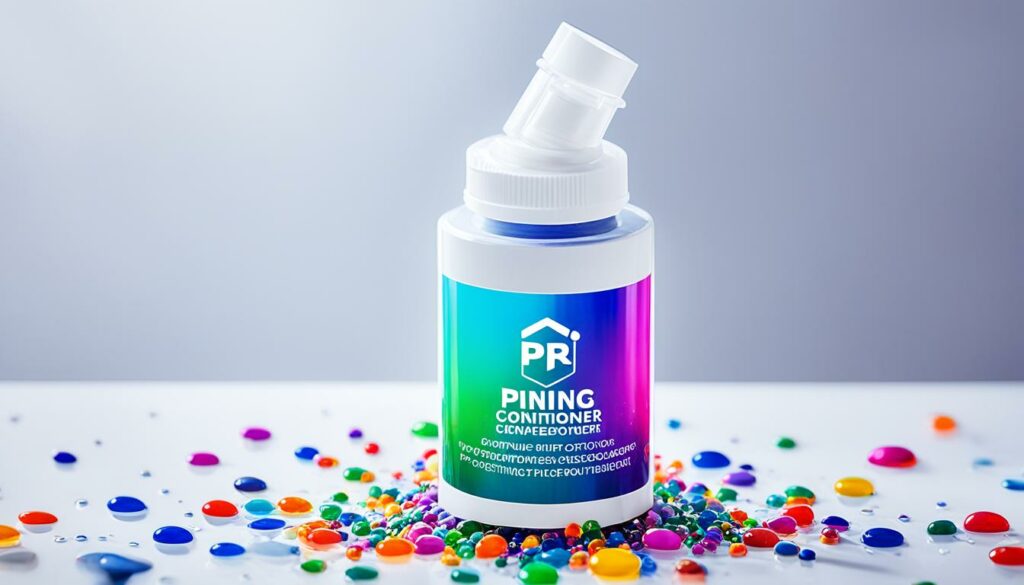
With the benefits of preventing clogging and maintaining moisture, using a printhead conditioner is a valuable addition to your printer maintenance routine. By investing in a quality conditioner and incorporating it into your regular maintenance schedule, you can prolong the lifespan of your printhead and enjoy hassle-free printing for years to come.
Exploring Wet Capping as a Clog Prevention Method
When it comes to preventing printhead clogging, wet capping is a method that deserves attention. This technique involves adding a cleaning solution to the capping station, which is a crucial component in maintaining printhead performance. By covering the capping station with cling film, you can ensure that the cleaning solution doesn’t drain away, leading to better moisture retention and a reduced risk of clogging.
Wet capping has gained popularity among printer enthusiasts and professionals alike due to its effectiveness in preventing clogs. It helps to maintain the optimal moisture levels around the printhead, which is essential for smooth ink flow and consistent print quality. By using cling film, you create a barrier that prevents the cleaning solution from evaporating or drying up, providing a protective layer that keeps the printhead in excellent condition.
Wet capping is an innovative and practical approach to printhead maintenance. It ensures that the cleaning solution remains in contact with the printhead, preventing dried ink or debris buildup that can lead to clogs. This method is especially useful when printers are left unused for an extended period.
To implement wet capping, start by applying the cleaning solution to the capping station. Ensure that the cleaning solution is compatible with your printer model and ink type. Then, carefully cover the capping station with cling film, creating a tight seal to prevent any leakage or evaporation.
Wet capping is particularly effective for printers with removable printheads as it allows for deep cleaning and maintenance. It’s a proactive method that can help prolong the lifespan of your printhead and ensure consistent print results.
Remember to follow the manufacturer’s recommendations and guidelines when using wet capping. It’s essential to choose the right cleaning solution and cling film to avoid any potential damage to your printer. A little extra care and attention can go a long way in preventing printhead clogging and maintaining optimal printer performance.
Next, we’ll explore another useful tool for printhead maintenance – Printer Jockey. This innovative software offers comprehensive preventive maintenance and printhead cleaning options, allowing you to maintain your printer’s performance effortlessly.
Importance of Printer Jockey for Printhead Maintenance
When it comes to maintaining the optimal condition of your printer’s printhead, Printer Jockey is an indispensable software tool. It offers a range of preventive maintenance and cleaning features designed specifically for printhead care. By using Printer Jockey, you can ensure that your printer operates at its best, delivering high-quality prints consistently.
One of the key benefits of Printer Jockey is its ability to perform regular printhead cleaning routines. This feature helps prevent printhead clogging, which can occur due to the accumulation of ink residue or dust particles. By running cleaning routines at regular intervals, you can keep the printhead clear and ensure the smooth flow of ink onto the paper.
Printer Jockey also allows you to print a few squares of white, which serves as a preventive maintenance technique. Printing white squares helps identify any issues with the printhead, such as clogged nozzles or inconsistent ink flow. By regularly printing these white squares, you can detect and address potential problems before they impact the print quality.
With Printer Jockey, you have complete control over the maintenance and cleaning process. You can choose from different cleaning options, such as deep cleaning or nozzle checks, depending on your specific needs. The software provides step-by-step instructions, making it easy even for users with minimal technical knowledge to perform the necessary maintenance tasks.
Additionally, Printer Jockey offers the convenience of automated maintenance scheduling. You can set up regular preventive maintenance routines, ensuring that your printer’s printhead receives the care it needs without requiring constant manual intervention. This automated approach helps to prolong the lifespan of your printhead and maintain consistent print quality over time.
Benefits of Printer Jockey for Printhead Maintenance:
- Prevents printhead clogging
- Improves ink flow and print quality
- Detects and addresses potential issues
- Offers a range of cleaning and maintenance options
- Provides step-by-step instructions
- Automates maintenance scheduling
By leveraging the power of Printer Jockey, you can proactively care for your printer’s printhead, ensuring it remains in optimal condition for longer. With regular preventive maintenance and cleaning, you can prevent clogs, improve print quality, and extend the lifespan of your printer, ultimately saving time and money.

| Printer Jockey Features | Description |
|---|---|
| Printhead Cleaning Routines | Perform specific cleaning routines to prevent clogging and maintain print quality. |
| White Squares Printing | Print a few squares of white to detect and address printhead issues. |
| Controlled Maintenance Options | Choose from different cleaning options and maintenance routines tailored to your needs. |
| Automated Maintenance Scheduling | Set up regular preventive maintenance schedules for hassle-free printhead care. |
Conclusion
Proper maintenance and care of the printhead are essential for preventing clogging and ensuring optimal print quality. By regularly using your printer and practicing routine cleaning, you can prevent clogs and maintain a steady ink flow for clear and crisp prints. It is also crucial to choose the right printer for your needs, considering factors like the metal core PCB and the printing method (inkjet or laser).
In addition to regular maintenance, using wetter solutions, conditioners, and wet capping techniques can help maintain moisture around the printhead and prevent ink drying. These methods further enhance the prevention of clogs, ensuring a smooth printing experience. And for specific printing methods like DTF and DTG, following the recommended cleaning process is crucial to keep the printhead clear and prevent blockages.
With these practices in place, you can keep your printhead from clogging and enjoy optimal print quality. Say goodbye to faded or streaky prints and embrace clear and vibrant results. Remember, preventive maintenance is key to a long-lasting and efficient printing experience. So, prioritize printhead care and maintenance to ensure the best possible output from your printer.

Morgan Azhari, the owner of PrinterUpdate.net, is a dedicated expert in the field of printers, leveraging a wealth of experience and education to create a platform that passionately shares insights and solutions.
With a goal to enhance the printer user experience, my vision for the website is to provide valuable content, making a positive impact on individuals navigating the complexities of printers.
